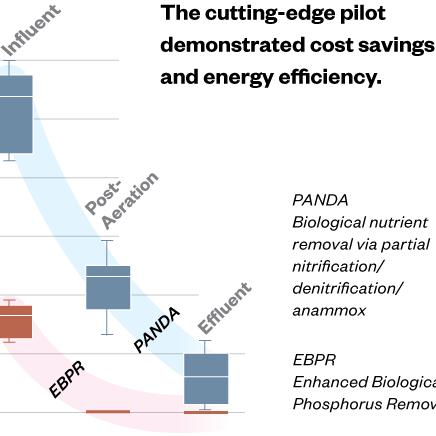Realizing the Benefits of Nutrient Recovery at WRRFs
Implementing nutrient recovery can help utilities reduce treatment costs and create valuable resources

Every day across the country, significant masses of nitrogen and phosphorous are discharged to water resource recovery facilities (WRRFs). WRRFs use biological or physio-chemical means to remove nutrients from wastewater, which generates solids enriched with nutrients. These solids can be stabilized before being beneficially reused as fertilizer or disposed.
Related Topics:

During anaerobic digestion, organic material is broken down to produce a bulk solution with high concentrations of ammonia (NH3), phosphorous (P), magnesium (Mg), calcium, iron, hydrogen, and potassium, among other compounds. High concentrations of these compounds combined with high pH and temperatures can stimulate precipitation of minerals in the digested sludge matrix. Many of these minerals have a high specific gravity and can precipitate within digestion and dewatering facilities.

Mitigating Nuisance Struvite Formation
One of the most common precipitates formed in WRRFs using biological phosphorus removal (Bio-P) and anaerobic digestion is struvite (magnesium ammonium phosphate). Left unchecked, struvite precipitate can plug pipes and affect downstream processes. Nuisance struvite formation can be mitigated using a combination of multiple strategies.

Nutrient Recovery Benefits
Implementing nutrient recovery can help utilities reduce costs associated with treatment while also allowing for the reuse of valuable resources within the agricultural sector as slow-release fertilizers.
- Reduce operating costs by offsetting aeration, supplemental carbon, and metal salt coagulant (where applicable).
- Reduce sludge and biosolids production.
- Reduce nuisance precipitate scaling.
- Reduce the impact of sidestream nutrient loads on the mainstream biological process and increase reliability of meeting effluent nutrient limits.
- Regain tank, pipeline, and pump capacity by reducing scaling.
- Improve sludge dewaterability, reducing dewatering polymer demand and increasing the cake dryness.
- Offset operating costs by selling the recovered product.
- Alter the phosphorus and nitrogen content of the biosolids product to one that is more favorable in regions with land application limitations due to P-indexing.
Nutrient Recovery Technologies
Phosphorus recovery technologies can be broadly categorized as either pre-dewatering recovery or post-dewatering recovery.
Struvite can be harvested from either system or it can be sequestered in biosolids and removed from the plant.
There are multiple commercially available options for phosphorus recovery in the United States. These technologies vary in reactor type, efficiency, and product formed, but the principle behind each are similar. In each system, struvite is precipitated in a dedicated reactor where the pH, conductivity, temperature, and chemical feed (e.g., magnesium, caustic) is used to stimulate supersaturated conditions that will promote precipitation. Although specific reactor configurations and control strategies vary among the different technologies, all can remove 80-90% of soluble phosphate and 10-30% of soluble ammonia.
Commercial companies offer a variety of options for purchasing recovered struvite, including buy-back of struvite and third-party purchasing.

Nutrient Recovery Case Studies
Post-Dewatering:
The F. Wayne Hill Water Resources Center (FWHWRC) is an advanced wastewater treatment facility with a capacity of 60 mgd. To address struvite issues and decrease the impacts of phosphorus recycle loads on the main liquid stream, while simultaneously recovering a sustainable fertilizer, Gwinnett County selected the OSTARA Pearl® nutrient recovery process coupled with WASSTRIP®.The nutrient recovery system includes a WASSTRIP® tank, two nutrient recovery reactors, centrate and filtrate storage tanks, transfer pumps, a fertilizer product handling system, and chemical feed systems. The WASSTRIP® process consists of a holding tank where primary sludge and WAS react anaerobically for 3–6 hours. The combined sludge is then thickened by rotary drum thickeners and the filtrate that is rich in phosphorous and magnesium is fed to the two recovery reactors. Each reactor has a nominal capacity of 4,400 pounds of struvite production per day.

Multiform Harvest offers high rate throughput (no recycle) and several configurations of the phosphorus release process. The product from the Multiform process is not finished fertilizer and requires further processing offsite.
-
75%
Reduction in alum addition for struvite control
-
1.5%
Increase in dewatered solids
-
2%
Increase in thickened solids
-
Decrease in dewatering polymer
We conducted a comprehensive evaluation of potential struvite precipitation strategies as part of this project.

Pre-Dewatering:
The Robert W Hite Treatment Facility (RWHTF) in Colorado is rated for 220 mgd and operates a Bio-P process. To manage nuisance struvite, ferric chloride is continuously dosed, pipelines are periodically pressure jetted, and two digesters are cleaned each year. The District evaluated pre- and post-dewatering recovery alternatives. Based on a comprehensive evaluation, the District decided to construct a pre-dewatering phosphorus recovery facility (PRF). The PRF measures 70 ft x 66 ft, which demonstrates that phosphorus recovery does not need to be a space intensive process. The reactor has an effective volume of approximately 378,000 gallons to provide a 7-10 hour hydraulic retention time to maximize struvite formation and recovery.











